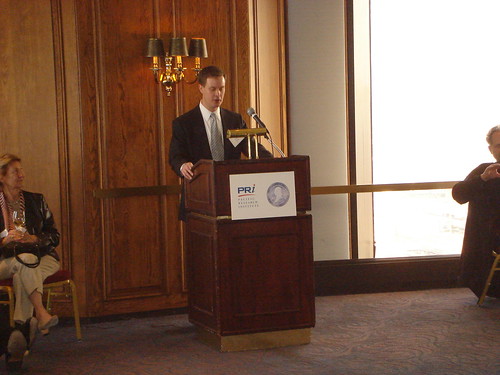 What better way to celebrate thanksgiving than to ponder envy? Helmut Schoeck‘s Envy: A Theory of Social Behavior (1969, German original 1966) makes the case that envy and envy avoidance are important determinants of human social behavior and that envy is greater when similarity is greater.
What better way to celebrate thanksgiving than to ponder envy? Helmut Schoeck‘s Envy: A Theory of Social Behavior (1969, German original 1966) makes the case that envy and envy avoidance are important determinants of human social behavior and that envy is greater when similarity is greater.
The envy Schoeck writes of is destructive. If I am jealous, I want to take what the other has. If I am envious, I want to destroy what the other has — the envied should be brought down to the envier’s level, at least. This desire for destruction is not bizarre if you adopt the mindset of a magic-filled and zero-sum world, apparently the norm for most of history and pre-history, and perhaps for most people in the world, still.
In such a world a good harvest or successful hunt may only be obtained through black magic which ensures others will not succeed. Apparently the evil eye and analogues intended to ward off the effects of envy are ubiquituous in pre-inudstrial human cultures, as are condemnation of envy and envy avoidance strategies.
If we accept that envy is important and detrimental, what to do about it? Schoeck argues that removing the apparent causes of envy by making everyone (more) equal will not help. A high school teacher is more likely than a manual laborer to envy a university professor, as the teacher can see himself in the professor’s shoes. Envy, or at least envy avoidance in the form of leadership position avoidance, was apparently rampant in kibbutzim, the largest and most sustained effort to build societies based on everyone-is-absolutely-equal principles, according to Schoeck (forty years later, the current Wikipedia article says “While the kibbutzim lasted for several generations as utopian communities, most of today’s kibbutzim are scarcely different from the capitalist enterprises and regular towns to which the kibbutzim were originally supposed to be alternatives.”) Perhaps the furthest claim made against absolute material equality by Schoeck is this (p. 342):
[Complete levelling] overlooks the important function of material inequalities. The envious man is able to endure his neighbour’s superiority as regards looks, youthfulness, children, married happiness, only by envying the other’s income, house, car and travels. Material factors form a socially necessary barrier against envy, protecting the person from physical attack.
Some of the ways mentioned by Schoeck that societies have mitigated envy (apart from condemning it) include belief in fate or luck (which can account for different outcomes in place of invidious magic), belief in non-envious gods, religious endorsement of individual achievement (i.e., some forms of protestantism), and commercial intermediaries. Regarding the last, Schoeck says a buyer will always be envied by a seller in pre-industrial society. Mass production and intermediaries perform envy arbitrage (my made up term) and thus remove a dangerous element hindering the division of labor.
While Schoeck surveys lots of historical, anthropological, personal, and literary anecdotes in support of his claims, it all seems rather hodge-podge. Most egregiously missing is any kind of evolutionary perspective. Animal (pp. 91-97) and psychology (pp. 98-105) experiments are mentioned, but all address envy indirectly at best. I suspect some of the anthropology Schoeck cites will have been discredited in the intervening forty years as well. One example I consider suspect (I mainly include it for your entertainment; I found it hilariously over the top) is Schoeck’s description of Maori muru raids (p. 391):
A man with property worth looting by the community could be certain of muru, even if the rea culprit was one of his most distant relatives. (The same kind of thing was observable during European witch trials.) If a Maori had an accident by which he was temporarily incapacitated, he suffered muru. Basically, any deviation from the daily norm, any expression of individuality, even through an accident, was sufficient occasion for the community to set upon an individual and his personal property.
The man whose wife committed adultery, the friends of a man who died, the father of a child that injured itself, the man who accidentally started a grass fire in a burial ground (even though no on had been buried there for a hundred years) are all examples–among innumerable others–of reasons on account of which an individual might lose his property, including his crops and his stores of food.
Did Dr. Seuss write this? A bit more:
In practice the institution of muru meant that no one could ever count on keeping any movable property, so that there could be no incentive to work for anything. No resistance was ever offered in case of a muru attack. This would not only have involved physical injury but, even worse, would have meant exclusion from taking part in any future muru attack. So it was better to submit to robbery by the community, in the hope of participating oneself in the next attack. The final result was that most movable property–a boat, for example–would circulate from one man to the next, and ultimately become public property.
So who was stupid enough to build the boat? Schoeck cites p. 87 of Eldon Best’s 1924 book The Maori, which is online, but doesn’t seem to say much more about muru than what Schoeck repeats above. A modern interpretation of muru seems to be here. A student paper on the Maori legal system largely citing this link is here, from the same Legal Systems Very Different From Ours class that produced an informative paper on the Aztec legal system I mentioned previously. I highly recommend checking out the site for that class or similar before assuming another culture’s institutions are so bizarre they could not serve a productive purpose.
Schoeck also claims in various places (e.g., p. 304) that society could not function without a modicum of envy, without which social controls would be impossible. On this topic he never moves beyond mere assertion and is not convincing. Innovation is another possible good outcome of envy, though Schoeck’s example is support of this seems rather lame (p. 403):
[T]he man in question may be a discontented, disregarded member of a primitive tribe who makes a show of being the first to be inoculated or treated by a Western doctor, in order to put his own medicine man’s nose out of joint. But his ‘courage,’ and the success of the treatment, induce other members of the tribe to follow his example, so that by degrees scientific medical care can be introduced. Thus, in this particular case (and disregarding certain side-effects), the envious man ‘who always sought to do harm’ had achieved something beneficial for his group.
A modern example may be one who works on free software in part to bring Bill Gates down; the former’s destructive urge is channeled into production.
…
I enjoyed reading Envy, and much of the enjoyment came not directly from the subject at hand, but from seeing the world through the eyes of a slightly different time period and culture. Some items I found interesting follow.
(p. 258) The Soviet Union had a seemingly low income tax (13 per cent) and high social stratification. Why bother with an income tax … presumably the state pays everyone? I know almost nothing about how communist economies actually functioned.
(p. 289)
[T]he young man who has hung around graduate school until he is twenty-six or twenty-eight to acquire his doctorate or M.A. in the (correct) belief that his college diploma was no longer of much significance is not really content to be a trainee in a bank of a business firm.
If there’s a trend at all, it’s older than I thought.
(pp. 330-332) The first Labour government in the UK produced a crisis of conscience in some of the new members of that government. They were dedicated to equality, but would be drawing high salaries in government. They got over it quickly.
(pp. 373)
In 1959, when the Soviet Union had already set its course unequivocally in the direction of private property and a consumer society
Was Schoeck amazingly prescient or engaging in wishful thinking? Was this conventional wisdom among sovietologists in the early 1960s, or would Schoeck have been considered crazy for this statement?
A biographical page included in the front of Envy contains this amazing sentence:
He was a student of medicine and psychology at the University of Munich from 1941 to 1945.
This sounds completely normal, until you consider the location and years. Schoeck would have been 19 in 1941. How did he escape the army? He looks able-bodied in a photograph. Someone I mentioned this to joked that perhaps Shoeck was so envied during this period for having avoided the Wehrmacht that he became obsessed with envy. What is the real story?
…
I found Envy interesting and Schoeck’s claims about the importance and nature of envy somewhat plausible, but the subject cries out for treatment by a modern social scientist with far more data, tools for data analysis, and evolutionary theory at hand. Perhaps Bryan Caplan will write such a book. I learned of Envy via one of Caplan’s posts.








